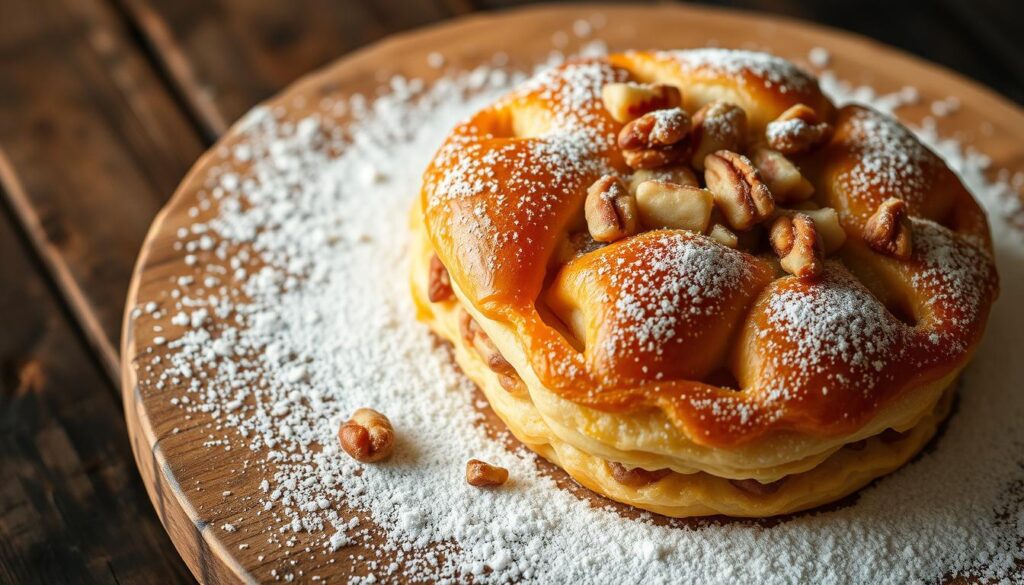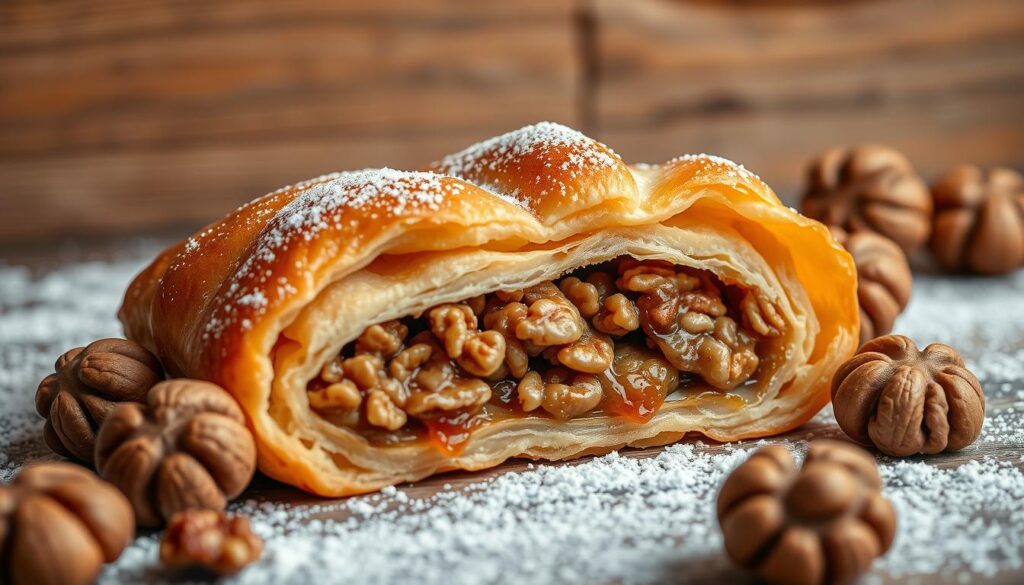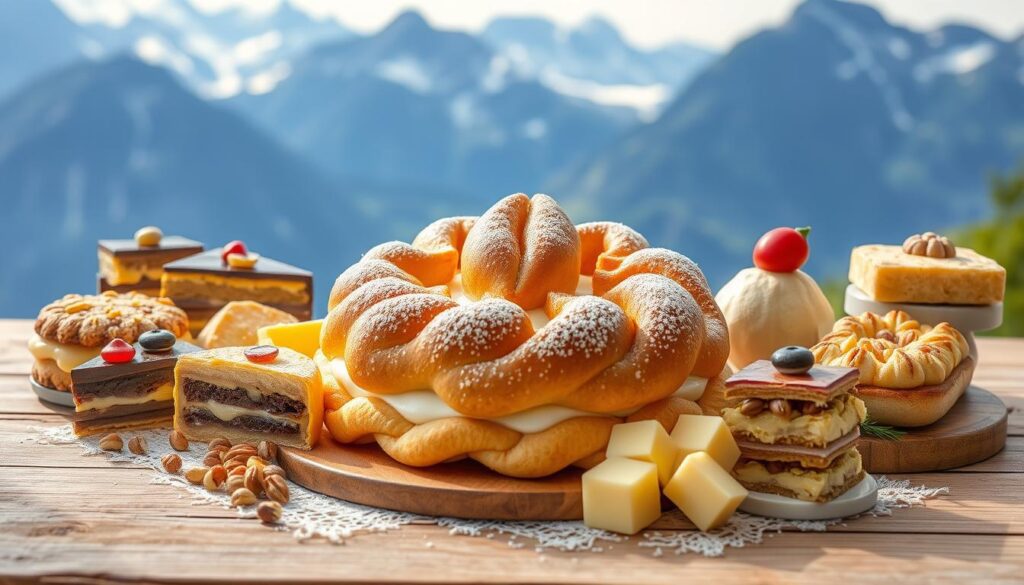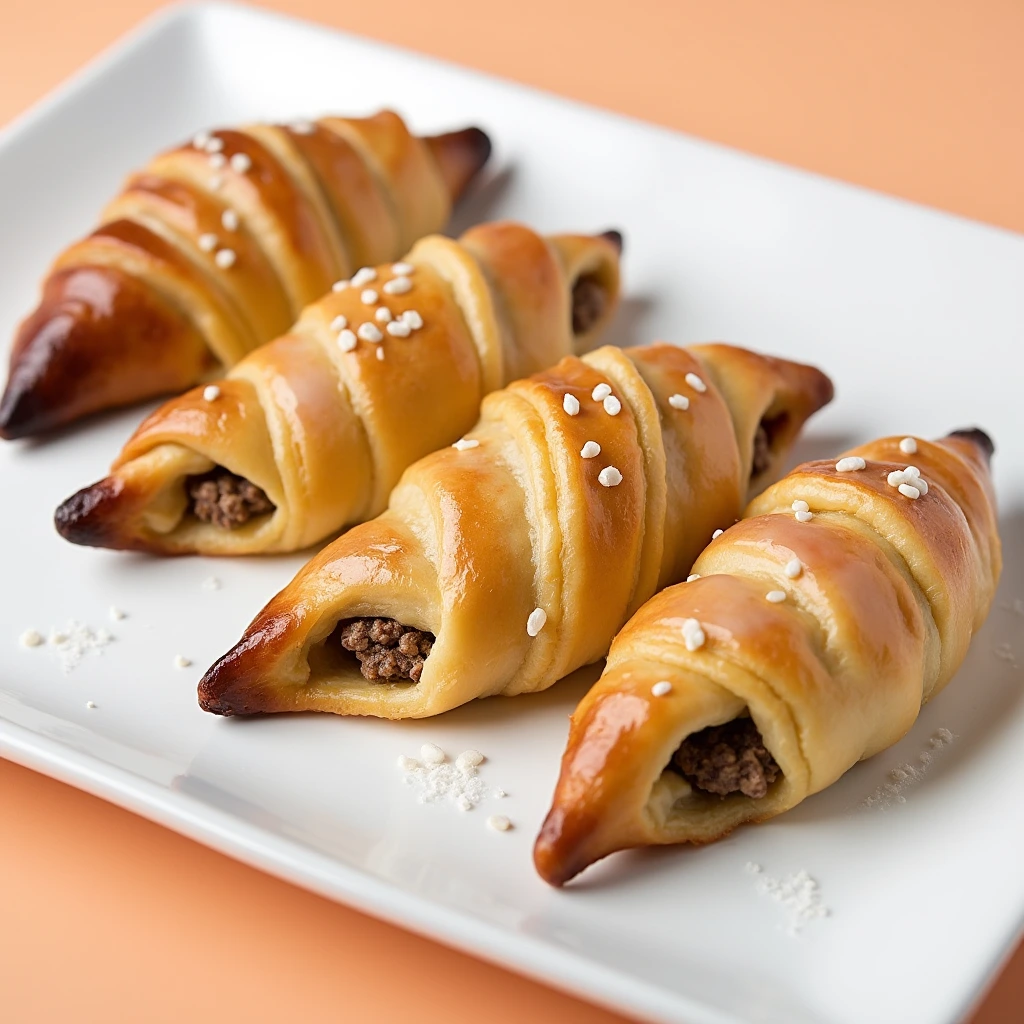The Nussgipfel is a traditional Swiss pastry known for its flaky layers and rich nut filling. It’s celebrated as a staple in Swiss baking. This pastry is famous in Switzerland and loved worldwide, giving a true taste of European cooking.
This Swiss pastry guide dives into the Nussgipfel’s history, how it’s made, and its place in Swiss cuisine. It uses top ingredients like fresh butter and sweet hazelnut filling. For those who love baking, the gipfeli recipe is a great way to try this beloved pastry.

Key Takeaways
- The Nussgipfel is a hallmark of Swiss pastry art, known for its nut-filled, flaky texture.
- Switzerland is recognized for producing some of the best breads and pastries globally.
- Properly made, Nussgipfel can offer a sweet and fragrant experience with ingredients like hazelnuts and butter.
- The gipfeli recipe highlights the use of high-quality bread flour for optimal results.
- Exploring the Nussgipfel is an enriching way to appreciate Swiss culinary traditions.
Definition of Nussgipfel
The Nussgipfel is a beloved Swiss pastry known for its unique taste and texture. It has a long history in Swiss baking, with a flaky, golden crust and a nutty filling. This pastry is more than just a treat; it’s a part of Swiss culture.
Origins of the Name
The name Nussgipfel comes from German. “Nuss” means nut, and “Gipfel” means peak. This name fits the pastry’s crescent shape perfectly. It was created in the 19th century, influenced by croissant trends from nearby countries.
Physical Characteristics
Nussgipfel is a feast for the eyes and taste buds. Its crust is flaky and golden, with a delightful crunch. The filling is made of ground hazelnuts or almonds, sweetened with spices like cinnamon. This mix of flavors and textures makes Nussgipfel a special treat for any occasion.

Importance in Swiss and European Cuisine
The Nussgipfel is a key part of Swiss and European pastry culture. It combines culinary heritage and tradition. In Swiss bakeries, it’s a big deal, showing its cultural importance.
Its history shows Switzerland’s love for quality. The country took ideas from other nations and made them their own. This shows how local traditions evolve.
Historical Context
In the late 19th century, pastry became more popular in Europe. Switzerland wanted to stand out with its own pastry. The Nussgipfel was born, with flavors and techniques that made it unique.
This shows how local culture shapes food. It’s a big part of Swiss cuisine, showing the country’s culinary identity.
Breakfast Staple and Beyond
The Nussgipfel is a favorite for breakfast in Switzerland. It’s enjoyed with coffee or tea, thanks to its flaky texture and nutty taste. It’s also great for snacks or other meals.
This shows its versatility. It’s a big part of Swiss dining, showing how food brings people together. It’s a symbol of community and family.

The Origin of Nussgipfel
The Nussgipfel is a Swiss pastry loved for its flaky layers, nut fillings, and sweet glaze. It’s a pastry that shows the culinary ties between Alpine regions. Its history and variations in Switzerland and nearby countries are fascinating.
Historical Background
The Nussgipfel dates back to the 19th century, when nuts like hazelnuts and almonds were common in the Alps. It combines French and Austrian croissant recipes with nutty fillings. Today, it’s a symbol of Swiss culinary tradition, blending with neighboring cultures.
Regional Variations in Switzerland and Nearby Countries
Nussgipfel has many versions, each reflecting local tastes and ingredients. In Switzerland, it’s made with puff pastry and sweet nuts. But, different regions in Switzerland and nearby countries have their own twists.
In Germany, it might have marzipan. Austria’s version could have fruit fillings. This shows how versatile and shared the pastry’s history is among Alpine nations.
| Country | Variation | Main Ingredients |
|---|---|---|
| Switzerland | Classic Nussgipfel | Puff pastry, ground almonds, icing sugar |
| Germany | Nussgipfel with Marzipan | Puff pastry, marzipan, hazelnuts |
| Austria | Fruit-Filled Nussgipfel | Puff pastry, fruit filling, ground nuts |
What is a Nussgipfel?
The Nussgipfel is a beloved pastry in Swiss culture. It’s more than just a tasty treat; it’s a symbol of Swiss traditions. This pastry is made with local ingredients and old baking methods.
It’s a big part of celebrations and holidays. It brings people together, sharing the joy of freshly baked goods.
Cultural Significance
Nussgipfel shows the skill and love of Swiss bakers. It’s not just about taste; it’s about unity and happiness in Swiss life. In many homes, it’s a special breakfast treat, enjoyed with coffee or tea.
This pastry is a key part of Swiss cuisine traditions. It uses local flavors and sustainable practices. Recipes passed down through generations celebrate the area’s mountainous heritage.
The Nussgipfel is a favorite breakfast item in Switzerland. It’s enjoyed at family gatherings or with friends. It reminds us of the value of community and togetherness, showing the deep pastry symbolism in its making and eating.
Ingredients and Variations
The Nussgipfel is a delightful mix of flavors and textures. It starts with puff pastry, butter, and flour for a tender crumb. These ingredients come together to create a unique taste.
Traditional Ingredients Used
Traditionally, Nussgipfel fillings include ground hazelnuts or almonds. They are sweetened with sugar and spiced with cinnamon. This mix creates a rich, nutty flavor that’s the heart of the pastry.
Variations in Fillings
There are many variations in nussgipfel fillings to try. While classic options are loved, some prefer walnuts for a deeper taste. Others add chocolate hazelnut spreads or dried fruits like apricots for a fruity twist. These changes let you tailor the taste to your liking.
Vegan and Gluten-Free Adaptations
Today, there’s a big push for inclusive baking. Vegan adaptations of nussgipfel use plant-based butter and dairy. Gluten-free versions use special flours to keep the pastry’s taste. This way, everyone can enjoy Nussgipfel, no matter their diet.
| Filling Type | Traditional Ingredients | Variations | Dietary Adaptations |
|---|---|---|---|
| Nut-Based | Hazelnuts, Almonds | Walnuts, Pecans | Vegan Nut Mix |
| Chocolate | – | Chocolate Hazelnut Spread | Vegan Chocolate Spread |
| Fruit | – | Dried Apricots, Cherries | Gluten-Free Fruit Mixture |
| Savory | – | Cheese | Vegan Cheese Substitute |
How Nussgipfel is Made
Making Nussgipfel is a fun journey into Swiss pastry making. This guide shows how to make this famous treat with a traditional recipe. Follow these steps for a flaky pastry with a delicious nutty filling.
Step-by-Step Traditional Recipe
To make nussgipfel, you’ll need:
- 500 g all-purpose flour
- 250 ml milk (at room temperature)
- 100 g ground hazelnuts
- 120 g granulated sugar
- 100 g unsalted butter
- Heavy cream and vanilla extract, as needed
- 100 g icing sugar for glaze
Start by making the dough. Mix flour, milk, and butter, then knead until it’s smooth. Let the dough rise for about an hour in a warm spot. For the filling, mix toasted nuts with sugar and a bit of cream for a rich taste.
When the dough is ready, roll it out and cut into triangles. Put some filling at the wide end and roll up each triangle, sealing the edges. Bake at 200°C/400°F for 18-20 minutes for a golden finish.
Techniques for Dough Preparation
Good baking techniques are key for nussgipfel. Keep the dough cold to make it flaky. Roll it out evenly for the best results.
A well-kneaded dough and enough rest time are important. This lets the gluten develop right, without overworking the dough.
Key Tips for Filling and Baking
Don’t overfill the nussgipfel to avoid leaks. Seal the edges well to keep the filling in. Keep an eye on the baking temperature for even baking.
After baking, dust with icing sugar for a sweet finish. This adds to both the look and taste of your nussgipfel.
Nussgipfel Recipe Inspiration
Nussgipfel pastry is a tasty way to enjoy nuts in different recipes. This section will show you the classic recipe and some new ideas to try.
Classic Nussgipfel Recipe
The classic nussgipfel recipe layers puff pastry with a nut filling. This filling is often made from hazelnuts or almonds. The pastry is rolled into a crescent shape, giving it a denser feel than French croissants.
Using top-quality ingredients is key to making this pastry. It results in a dish that’s both filling and delicious.
Creative Twists on the Traditional Recipe
Trying new things can make your nussgipfel even better. You can add chocolate to the nut filling or use spices like cardamom or cinnamon. This adds a special flavor to your pastry.
There are also recipes for those who follow vegan or gluten-free diets. Some use cream cheese or Nutella as fillings. Others stick to traditional flavors but with a local twist, like Bündner nussgipfel with walnut filling.
Each new idea keeps the essence of the pastry alive. It lets bakers make it their own, matching their personal taste.
Serving Suggestions for Nussgipfel
Nussgipfel is best enjoyed warm, bringing out its nutty sweetness. Pair it with a strong espresso or creamy cappuccino for a perfect match. A soothing tea can also complement its flavors, making your snack or breakfast special.
Pairing with Beverages
Choose drinks that contrast and enhance Nussgipfel’s flavors. A chocolatey mocha adds a luxurious touch, while orange or cranberry juices offer a refreshing twist. For a fancy brunch, try pairing it with sparkling wine. These options ensure there’s a perfect drink for every taste.
Presentation Ideas
Presenting Nussgipfel beautifully can make it even more enjoyable. Place them on elegant platters and dust with powdered sugar. A simple icing drizzle can add elegance, perfect for breakfast or afternoon teas. This way, you create a memorable experience that celebrates Swiss culinary traditions.
FAQ
What is a Nussgipfel?
The Nussgipfel is a Swiss pastry with a flaky, crescent shape. It has a rich, nut-filled interior. The nuts are usually hazelnuts or almonds, sweetened and spiced with cinnamon.
What are the origins of the Nussgipfel?
The name “Nussgipfel” comes from German, meaning nut and peak. It refers to its crescent shape. This pastry has roots from the 19th century, influenced by French and Austrian pastries.
How is Nussgipfel prepared?
To make Nussgipfel, puff pastry is rolled out and filled with a nut mixture. It’s then shaped into crescents and baked until golden. Keeping the pastry cold is key for flakiness.
Can I find variations of Nussgipfel?
Yes, there are many Nussgipfel variations. Some use walnuts or chocolate hazelnut. There are also vegan and gluten-free options for dietary needs.
When is Nussgipfel typically enjoyed?
Nussgipfel is a breakfast favorite, often with coffee or tea. It’s also a hit during Swiss celebrations.
How should I serve Nussgipfel?
Serve Nussgipfel warm. Dust with powdered sugar or drizzle icing for a nice touch. It’s great with espresso, cappuccino, or tea, perfect for brunch or dessert.
Is it easy to make Nussgipfel at home?
Making Nussgipfel at home is easy with the right ingredients and techniques. Follow a traditional recipe and practice dough handling for delicious results.
What is the cultural significance of Nussgipfel?
Nussgipfel is more than a tasty pastry. It represents Swiss culinary heritage. It showcases local ingredients and traditional baking, making it a highlight of communal celebrations.

